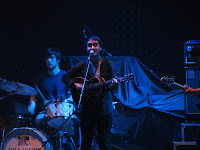 Working Man's PoetWarning: total setlist spoiler.
Working Man's PoetWarning: total setlist spoiler."How many of you have bought the new album?" asked Guy Garvey of Tuesday night's SECC audience. Some hands went up.
"The rest of you are dragging your heels a bit!"Guilty. Last year, when Guy announced Elbow were going into the recording studio, "to make a record for children", I can't have been the only one to cringe.
OMG, it's unbearable. They're going to cover
Bob The Builder. That dread only increased when I saw the track title
Lippy Kids. And again, when I
heard the name of the new CD:
Build A Rocket Boys!I never guessed that name could be one half of a most expressive couplet, concisely (and yes, a little sentimentally) devised to speak across the generations. In case of any doubt, the working man's poet set the scene Tuesday night, relating how he was given pause by his own reaction to some kids on a street corner. "They're just young people, but older people are wary of them.
And all those right wing bastards feed on that." Okay, I guess you'll not be wanting your
Daily Mail delivered, eh Guy.
Do they know - those - days
are golden?
Build a rocket, boys!
Sensitively succinct, wistfully nostalgic, literally
essential - full of life.
PanicI'd bought the tickets for Linda, Christmas 2010. Earlier, actually.
After our previous experience trying to get in and out of the SECC car park, for a John Bishop show at the Auditorium, we'd decided to take the full day off this time. Arrive early, get some dinner at the hall. But fates conspired to thwart us. I had to run a mercy errand that took up the whole afternoon. Then at the last minute, we discovered the show was at 7:30, not 8pm. Chucking some Heinz low fat macaroni cheese and toast down our necks, we ran.
 Villagers
VillagersAnd so we arrived to find the support act, Dublin folk collective
Villagers, already on stage playing songs from the Mercury nominated debut,
Becoming A Jackal. "I love them!" was Linda's reaction, as she lovingly wiped a stray cheese macaronum from my chin. "Who are they like?"
There's a job for you, identifying front man, singer, songwriter and multi instrumentalist Conor J O'Brien's musical, lyrical, arrangement and production influences. All are diversity. Minute by minute, his songwriting inspiration might come from anywhere: now, the genius of Dylan's
Positively 4th Street; next, Elton's
Tiny Dancer. Musically, I found one undisputable Del Amitri reference. Linda heard Fleet Foxes. Writing in the
Irish Times, Shane Hegarty may be right that Conor's Irishness isn't a factor, he could as easily be from Northampton or New York or anywhere; but I heard Feargal Sharkey
twice.
Not that Conor lacks originality.
Exactly the opposite. He is
eclectic. He shares with a very few of the best modern tunesmiths, Charlotte Hatherley among them, that uncanny ability to weave something utterly new and good, from that tiny kit of just twelve notes. It's so very nearly impossible, inventing in this domain, something simple - a chord progression, a melody - that's simultaneously new and pleasing to the ear.
Ship Of Promises boasts a hook-laden embarrassment of such riches, from interchanging chord patterns shifting under a repeating theme, through Neil Hannon-inspired baroque bridges, to its dying discordant howling suspensions.
Later we would return to the merchandising area to buy the
Villagers CD. But for now,
Villagers were really great live, with
Pieces in particular - introduced by Conor as "a blues style thing" - benefiting especially well from the live atmosphere, and sounding remarkably better than the studio version. Which given that Conor played all instruments (except strings & french horn) on the CD, maybe isn't too surprising at all.
It's not the first time we have been treated to a "surprise" fantastic support band over the years, ever since seeing
Simply Red at this same venue in the 80s, so very ably supported by Doreen Edwards's brilliant
Distant Cousins.
Villagers are supporting
Elbow throughout this short tour. No sooner had Linda compared them to
Fleet Foxes, than we discovered that these very same two are on the very same bill at
The Very Eden Project this very July.
 Elbow
ElbowDuring the break, picture frames on the projection screen displayed the five members of Elbow, posing live as for portraits. Eventually these avatars walked out of frame, then the band appeared on to the live stage, launching straight into their new CD opener
The Birds. After
The Bones Of You, we were into another new masterpiece,
Lippy Kids.
My personal favourite
Mirrorball, complete with appropriate visual accompaniment, came up pleasingly early in the set. A great singalong, I couldn't resist playing air piano at the end of each chorus. Next,
With Love inevitably became an audience participation highlight, followed by the single
Neat Little Rows, the beautiful
The Night Will Always Win, and
Great Expectations.
 Grounds For Divorce
Grounds For Divorce was another (still more literal) highlight, belted out with fury by band and audience alike, the light show blinding us during the spikes. Then came
The Loneliness of a Tower Crane Driver, with its breathtaking pauses, followed by the cut down
Puncture Repair,
Some Riot, and both informal acoustic and full band renditions of
Perfect Weather To Fly.
After
Open Arms, the band thanked us and exited, fooling nobody. Well, they hadn't yet played
One Day Like This. With which, returning one obligatory standing ovation later to serve up the brass pillars of
Starlings followed by
Station Approach, they duly closed the set.

Speaking of which, there are a few surprising setlist omissions in there. They didn't play Linda's favourite,
An Audience With The Pope, for this audience; while the stylistically similar
The Fix Is In was also out - possibly for want of a duet partner. And no
Leaders of the Free World - atopical perhaps? - or
Scattered Black and Whites. But the new material was plenty strong enough to dispel any hint of disappointment.
The light shows and projection content were every bit as subtly, thoughtfully and artistically composed as is the music of Elbow. Time and again the tasteful special effects would build to a climax matching exactly their accompanying musical crescendo.
And just a quick word about the sound. Actually, it was very good. Unaccountably so, given the horrendous acoustics of that big bloody shed. I swore after my last Arcade Fire experience (who sounded like The Jesus And Mary Chain, only with distorted vocals) I'd never go back there again. And had these tickets not been for Linda, I still wouldn't. Have. Had.
 Chat
ChatThis was Elbow's first night, on their
very first ever big arena tour. I mean,
can you imagine? One concern previously voiced by Guy was that the band's accustomed intimacy and connection with the audience might be difficult to achieve in such a setting. But he needn't have worried. Seemingly effortlessly, they achieved all that and a big bag of chips. Spokesman Guy's patter was of course key, as when he asked everyone to raise their glasses and toast the bloke in block C, row R, seat 31 - the seat furthest from the stage. Guy called him out by name, even making him descend a few stairs to accept the spotlight and the warm thanks and standing ovation from everyone else in the hall.

Guy's introductions grew into short stories, illuminating the inspiration for each song. Interspersed were repeated admissions of just how nervous the band were. Someone asked why, prompting the answer
"Why? Look at you! There's fucking thousands of you!" (never has he sounded more like Johnny Vegas).
There were intimate set pieces where the band would come together in a close circle for a short song or two. One of these, around the upright piano stationed at the end of what Guy called "me catwalk", a raised promenade stretching into the middle of the arena, raised a lot of laughs when he lifted the piano top to reveal a built-in illuminated cocktail cabinet, and proceeded to serve drinks to the band. Though not to the orchestra, about whom he confided "We pay them peanuts." Came Glasgow's answer:
"Well, sort it out!" Home
HomeI'd promised to make up for the missed dinner date by taking Linda to an all-night MacDonald's. Yeah, she is easily pleased, I've noticed that too.
But before that, we had to detour to a 24hr Tesco, where we finally managed to get a copy of the new Elbow CD (ironically given Guy's complaint, there were none on sale at the venue). And, a bunch of other stuff, because you know,
midnight shopping!
Then burgers, then home about 2am. And despite having work the next day, we actually stayed up for a few more hours, playing our new
Villagers and
Elbow CDs.
We agree: this gig was the best standard of pure entertainment that we have ever experienced from a band.
Ten out of ten.CodaJust recently, I finally made good on another of last Christmas's promises: buying a few magazine gift subscriptions for some nieces and nephews. You see, throughout the 60s and early 70s, my own Aunt Margaret (that "mercy errand" above was for her) did this for her only nephew, supplying me regularly and reliably with years' and years' worth of
Tell Me Why and
World Of Wonder. I wanted to do something similar. Educational or creative, their choice; so long as one or other half of the brain is nourished. Little Niece chose
The Artist. The boys went for
How It Works.
Do they know - those - days
are golden?
Build a rocket, boys!
Song lyrics: copyright © 2011 by Guy Garvey. Photography: copyright © 2011 by Linda Kerr.
 Structured Exception Handler Overwrite Protection
Structured Exception Handler Overwrite Protection

























